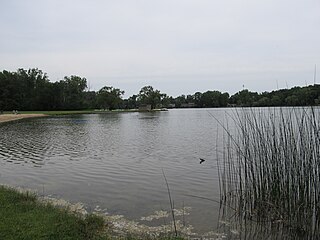 W
WBelknap Hill, is a prominent river bluff directly northeast of downtown Grand Rapids, Michigan. The hill is a distinct topographical feature when viewed from the Western approach to the downtown area. Evening romancers and view seekers throughout the history of Grand Rapids have favored its two hillside city parks. Belknap Hill holds a nostalgic place in the sentiments of Grand Rapidians in that it has long been a popular place to propose marriage. Hidden in the backwaters of the semi-isolated Belknap Lookout neighborhood atop this hill remain some of the simple nineteenth century framed homes from days when Belknap Hill bordered small farms and apple orchards. A cherished historic feature of the hill is the steeply inclined Trowbridge and North Street which are the city's Two fieldstone cobblestoned streets.
 W
WColdbrook Creek is an urban stream in Grand Rapids in Kent County, Michigan. Its origin is the outflow of Fisk Lake on the John W. Blodgett Estate, and the stream eventually drains to the Grand River. Although parts of the stream are now in underground culverts, there are significant possibilities for daylighting, and open streambeds appear in areas on the campus of Aquinas College as well as within Highland Park. Part of its course through Grand Rapids is parallel to the Grand Rapids Eastern Railroad.
 W
WFrederik Meijer Gardens & Sculpture Park is a 158-acre (64 ha) botanical garden, art museum, and outdoor sculpture park located in Grand Rapids Township, Michigan, United States. Opened in 1995, Meijer Gardens quickly established itself in the Midwest as a major cultural attraction jointly focused on horticulture and sculpture.
 W
WGrand Rapids Medical Mile is a designated area within the city of Grand Rapids, Michigan. It began with medical-related development in the Hillside District of Grand Rapids, Michigan, bordering both sides of Michigan Street. More than a decade later it encompasses an area five times larger, expanding east further down Michigan St.and north across Interstate 196. It has also been referred to as Grand Rapids Medical Corridor, Michigan Street Medical Corridor, Health Hill, Medical Hill, and Pill Hill, among other names.
 W
WThe Grand River is a river in the southwestern portion of the southern peninsula of Michigan, United States, that flows into Lake Michigan's southeastern shore. It is the longest river in the U.S. state of Michigan, running 252 miles (406 km) from its headwaters in Hillsdale County on the southern border north to Lansing and west to its mouth on the Lake at Grand Haven. Native Americans who lived along the river before the arrival of the French and British called the river O-wash-ta-nong, meaning "Far-away-water'", because of its length.
 W
WJohn Ball Zoological Garden is an urban park located on the west side of the city of Grand Rapids, Michigan, United States. The John Ball Zoo is situated on the ravines and bluffs along the west edge of the park.
 W
WLamberton Lake is a 28.5-acre (115,000 m2) freshwater lake located in Kent County in Western Michigan. The lake is approximately 1,700 feet (520 m) long and 1,040 feet (320 m) wide and is centered at 43.02°N 85.63°W just within the city limits in northeast Grand Rapids. The surface elevation is 650 feet (200 m), and most of the lake is less than 15 feet (4.6 m) deep. There is one island in the lake, approximately 160 feet (49 m) long and 70 feet (21 m) wide, located in the northwest part of the lake. A low ridge runs along the east side of the lake and overlooks it.
 W
WPlaster Creek is a 25.9-mile-long (41.7 km) urban stream in Kent County, Michigan in the United States. It is a tributary of the Grand River. The stream is named for the large deposit of gypsum found at its mouth. Its mean monthly flow averages 22 million gallons per day.